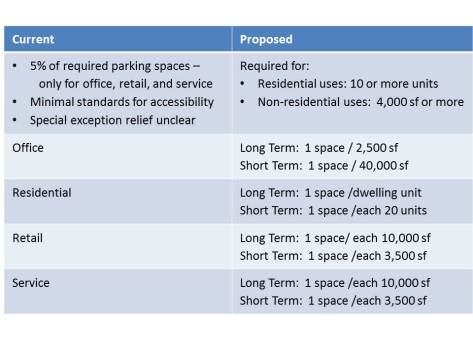Last week, OP noted that we are revising our proposed parking requirements; a reexamination based on the comments we received as part of our extensive public process, and a reevaluation of how new parking standards could and should be implemented. Many people have commented on this, and a few people have contacted us to get more information on this new draft text.
Well, we are still working on the actual text, but below is a summary of what we are working on. Some of the provisions are different; some will look familiar because we are not proposing to change them. Of course, this is a work in progress; aspects may change by the time the draft text is complete but we wanted you to know where we are headed.
Summary of current proposal:
• Eliminate separate transit zone text. This means that, unlike in earlier proposals, all parking regulations would be adopted as a comprehensive part of this ZRR process, not requiring additional, subsequent processes to map and implement separate transit zones.
• For any use, allow 50% by-right reduction in required parking for sites located close to transit (1/2 mile from a metro station, or ¼ mile from a streetcar line or WMATA bus route identified as part of the Priority Corridor Network).
• Low density residential zones: retain existing one space per lot requirement; except no on-site parking would be required where there is no alley access.
o Strong neighborhood concern about total elimination of requirement; likely to have minimal impact as providing on-site parking is standard practice.
o Addresses properties that cannot access parking from an improved alley; new curb cuts eliminate street parking (no net gain), negatively impacts streetscape character, can result in loss of street trees, and can create safety issues.
• Multi-family residential: standardize minimum parking requirement of 1 / 3 units greater than 4 units, and
More…

